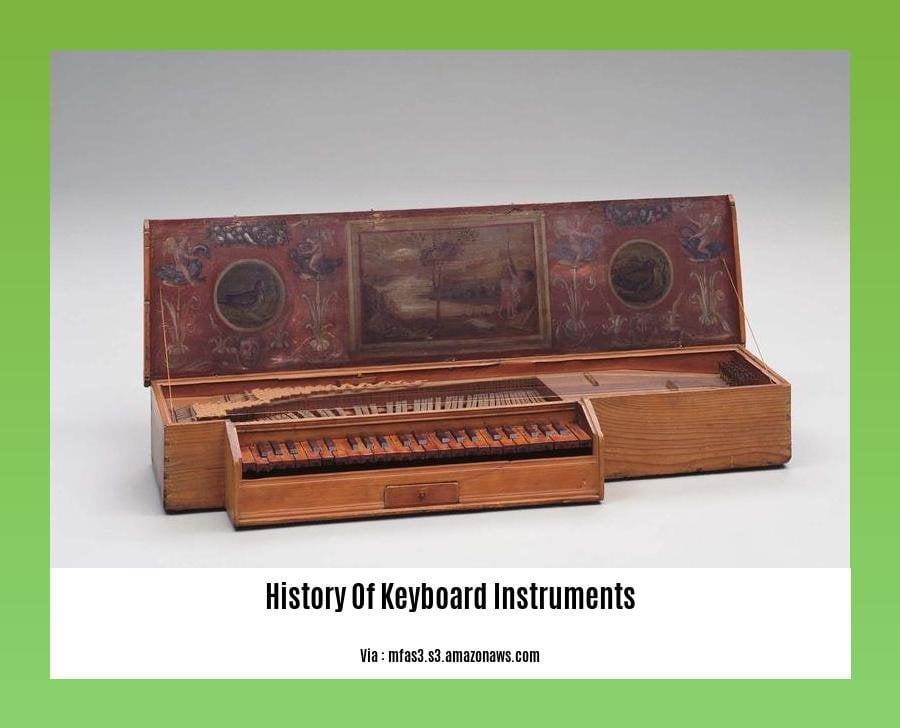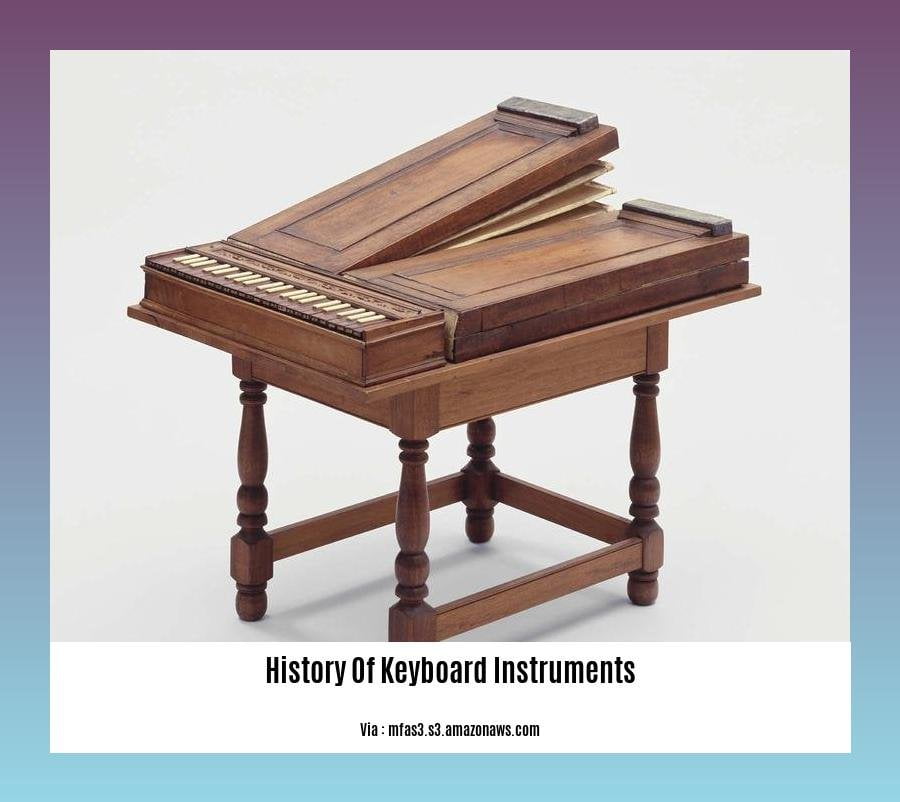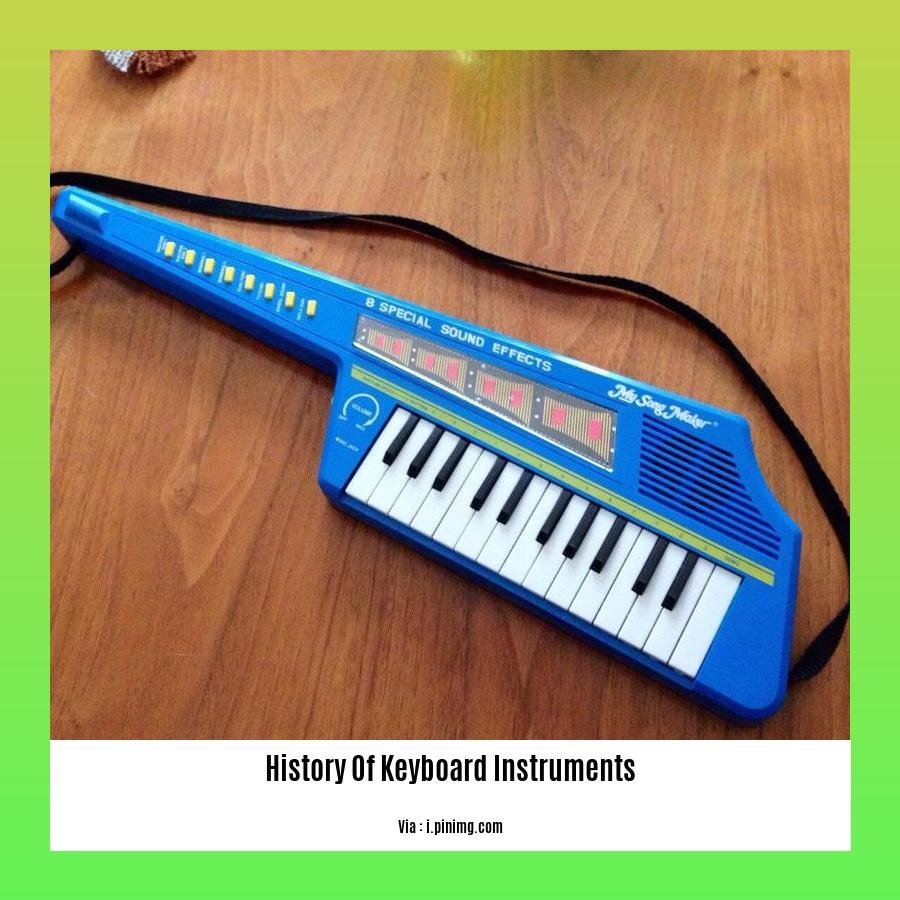Prepare to embark on a riveting journey through time as we delve into the captivating history of keyboard instruments in our article, [Unveiling the History of Keyboard Instruments: A Voyage Through Time]. From the earliest predecessors to the sophisticated instruments we know today, we’ll explore the fascinating evolution that has shaped the world of music.
Key Takeaways:
- Prior to the 14th century, keyboards were used in supporting roles, or to play transcriptions of other music.
- The earliest-known source of keyboard music is the Robertsbridge Codex.
- The clavichord gained popularity during the 16th-century, especially with Bach.
- The first harpsichord in the history of the piano was the virginal.
- Bartolomeo Cristofori invented the piano in the early 18th century.
- Beethoven played an early version of the piano called the fortepiano.
- The upright piano was invented in the early 19th century.
History of Keyboard Instruments

In the realm of music, keyboard instruments hold a significant place, enchanting us with their melodious notes and captivating harmonies. Let’s embark on a fascinating journey through time, exploring the rich history of keyboard instruments, from their humble beginnings to their modern-day prominence.
Early Innovations and the Birth of Keyboard Music:
- Long before the advent of pianos and organs, early innovators crafted rudimentary keyboard instruments as accompaniments to religious ceremonies and social gatherings.
- The organ, with its majestic pipes and bellows, emerged as one of the earliest keyboard instruments, filling cathedrals with its ethereal sounds.
- The Robertsbridge Codex, hailing from the 14th century, stands as the oldest surviving collection of keyboard music, offering a glimpse into the early repertoire of these instruments.
The Renaissance Revolution and the Rise of the Clavichord:
- During the Renaissance, the clavichord rose to prominence, captivating composers and musicians alike with its delicate touch and expressive capabilities.
- Johann Sebastian Bach, a master of the Baroque era, embraced the clavichord, using it to create intimate and soulful compositions.
The Harpsichord’s Reign and the Birth of the Piano:
- The harpsichord, with its bright and twangy sound, took center stage in the Baroque and Classical periods, becoming a favorite instrument for composers like Handel and Scarlatti.
- The virginal, a smaller version of the harpsichord, made its mark in the early days of keyboard history.
- Bartolomeo Cristofori, an Italian craftsman, revolutionized the world of keyboard instruments with his invention of the piano in the early 18th century.
The Piano’s Triumph and its Evolution:
- The piano, with its ability to produce a wide range of dynamics and expression, quickly gained popularity, becoming the instrument of choice for composers and performers.
- Beethoven, a towering figure in the world of classical music, embraced the piano, using it to create some of his most iconic works.
- The 19th century witnessed the birth of the upright piano, which brought the instrument to smaller homes and venues, further expanding its reach.
Modern Innovations and the Digital Age:
- The 20th century heralded the advent of electronic keyboards, synthesizers, and digital pianos, opening up new sonic possibilities and transforming the sound of modern music.
- These instruments, with their versatility and affordability, made the joy of playing keyboard instruments accessible to a wider audience.
As we traverse the history of keyboard instruments, we witness a remarkable journey of innovation, artistry, and cultural significance. From the organ’s sacred tones to the piano’s expressive melodies, these instruments have left an indelible mark on Western music, shaping its sound and inspiring countless composers and performers.
Join us as we continue to explore the captivating world of keyboard instruments, uncovering their hidden stories and delving into the rich tapestry of their musical legacy.
- To learn the fascinating past of JDM cars, click here: history of jdm
- Interested in the historical evolution of kitesurfing? Discover its rich history here: history of kitesurfing
- Explore the comprehensive timeline of lacrosse’s development through the ages: history of lacrosse timeline
Baroque Innovations: The Rise of the Harpsichord and the Influence of the French and German Schools

In the vibrant tapestry of musical instruments, the harpsichord stands as a testament to the ingenuity and artistry of the Baroque era. Its delicate plucking sound, capable of producing a rich and varied range of timbres, captivated composers, performers, and audiences alike. As the harpsichord’s popularity soared during the 17th and 18th centuries, it became a staple of courtly gatherings, theatrical productions, and concert halls, leaving an indelible mark on the musical landscape of the era.
Evolution of the Harpsichord: From Italy to the European Courts
The origins of the harpsichord can be traced back to the Italian Renaissance, where instruments resembling the modern harpsichord began to emerge around the late 14th century. Known as the clavicembalo, these early instruments were small in size and often used in intimate chamber settings. As the instrument’s popularity grew, it underwent a series of modifications and improvements, leading to the development of larger and more powerful harpsichords capable of filling the grand spaces of European courts and theaters.
The French Harpsichord: Elegance and Virtuosity
In France, the harpsichord reached new heights of elegance and refinement, largely due to the contributions of the Ruckers family of instrument makers. Their instruments, known for their intricate craftsmanship and responsive touch, quickly became the preferred choice of professional musicians and aristocratic patrons. French harpsichords were characterized by their distinctive shape, with a curved body and a soundboard decorated with elaborate paintings. Composers such as François Couperin and Jean-Philippe Rameau embraced the expressive potential of the French harpsichord, writing works that showcased its virtuosic capabilities and delicate nuances.
The German Harpsichord: Power and Versatility
In parallel with the developments in France, Germany emerged as another prominent center of harpsichord making. German harpsichords, known for their robust construction and powerful sound, were favored by composers such as Johann Sebastian Bach, who utilized their versatility to create his monumental keyboard works. These instruments often featured multiple keyboards, allowing for complex layering of sounds and dynamic contrasts. German makers such as Gottfried Silbermann and Christian Zell crafted harpsichords that were capable of producing a wide range of colors and textures, contributing to the rich and diverse soundscape of the German Baroque.
The Harpsichord’s Influence on Music
The harpsichord’s influence on Western music is profound and multifaceted. It played a crucial role in the development of keyboard techniques, shaping the articulation and finger work of generations of musicians. Composers from Handel to Scarlatti explored the unique sonic possibilities of the harpsichord, writing works that pushed the boundaries of musical expression and virtuosity. The harpsichord’s contribution to opera, chamber music, and solo repertoire is immense, leaving an indelible mark on the history of Western classical music.
Key Takeaways:
The harpsichord emerged in the Italian Renaissance and evolved into a sophisticated instrument during the Baroque era.
French harpsichords, crafted by the Ruckers family, were known for their elegance, responsive touch, and intricate decorations.
German harpsichords, favored by composers like Bach, were characterized by their robust construction, powerful sound, and versatility.
The harpsichord’s unique sound and expressive capabilities influenced keyboard techniques and inspired a vast repertoire of music.
Composers such as Couperin, Rameau, Handel, and Scarlatti wrote works that showcased the harpsichord’s virtuosic potential and diverse timbres.
Citation:
The Harpsichord – Elbphilharmonie Mediathek. (2019). [The Harpsichord] Link: https://www.elbphilharmonie.de/en/mediatheque/the-harpsichord/101
Britannica, T. Editors of Encyclopedia (2023, January 24). harpsichord. Encyclopedia Britannica.
Pianos Take Center Stage: The Birth and Evolution of the Modern Piano
In the captivating history of music, the piano reigns supreme, its melodious notes reverberating through the centuries, enchanting audiences with its rich sound and unparalleled expressiveness. Let’s delve into the extraordinary journey of this remarkable instrument, from its humble beginnings to its triumphant status as a cornerstone of Western music.
Key Takeaways:
Genesis of the Piano: The piano’s lineage can be traced back to the ancient Chinese stringed instrument, the “ke,” plucked to produce enchanting melodies.
Pythagoras’s Legacy: The renowned Greek philosopher, Pythagoras, laid the foundation for Western music theory, delving into the intricacies of musical sounds.
Birth of the Pianoforte: In the 18th century, Bartolomeo Cristofori, a gifted Italian instrument maker, crafted the pianoforte, the forerunner to the modern piano.
A Forerunner Emerges: Cristofori’s invention marked a pivotal moment, introducing the ability to control the volume of sound, a revolutionary concept in keyboard instruments.
German Refinement: Gottfried Silbermann, a German craftsman, enhanced Cristofori’s design, creating a more robust and expressive instrument.
A Star Ascends: By the 18th century, the pianoforte eclipsed the harpsichord, becoming the preferred keyboard instrument in Europe, captivating composers and audiences alike.
Viennese Ingenuity: Piano makers in Vienna, such as Anton Walter and Johann Andreas Stein, further refined the piano’s mechanics and enriched its sound.
Double Escapement Revolution: Henri Herz’s double escapement mechanism, introduced in 1826, enabled faster repetition of notes, expanding the piano’s expressive range.
The Ironclad Frame: Alexandre Debain’s iron frame, developed in 1855, provided greater stability, allowing for higher string tension and a more resonant sound.
Steinway’s Innovations: Steinway & Sons, an American piano manufacturer, revolutionized the instrument with the overstrung scale and other advancements, solidifying their position as industry leaders.
A Household Staple: In the late 19th and early 20th centuries, the piano reached its zenith as a ubiquitous household instrument, gracing parlors and serving as a tool for musical expression and education.
Electronic Evolution: The 20th century witnessed the rise of electronic instruments, leading to a decline in the popularity of the acoustic piano, yet it remained an essential element in classical music and jazz.
Conclusion:
The piano’s journey is a testament to human ingenuity and the enduring power of music. From its humble origins to its position as a cornerstone of Western music, the piano has captivated hearts and minds, inspiring generations of musicians and composers. Its enduring legacy as a symbol of creativity and expression ensures that the piano will continue to enchant audiences for centuries to come.
References:
- A Brief History Of The Piano: Its Origins And Evolution
- History of the Piano – The Invention of the Piano
**Electronic Era: The Advent of Synthesizers and Digital Keyboards and Their Impact on Contemporary Music**
In the vast landscape of musical history, the evolution of keyboard instruments mirrors the advancement of technology. With the dawn of the electronic era, the advent of synthesizers and digital keyboards has revolutionized the way we create and experience music. Let’s delve into this fascinating journey and explore how these instruments have transformed contemporary music.
Unleashing the Power of Sound Synthesis
The invention of the synthesizer marked a pivotal moment in the history of electronic music. These instruments mimicked the inner workings of traditional instruments by using electronic circuits to generate sound waves. This allowed musicians to escape the limitations of acoustic instruments and embark on a voyage of sonic exploration.
Synthesizers offered unparalleled control over various aspects of sound, including pitch, timbre, attack, decay, sustain, and release. With the twist of a knob or the slide of a fader, musicians could craft and manipulate soundscapes that defied conventional boundaries, pushing the frontiers of musical expression.
The Digital Revolution Takes Hold
As technology advanced, the advent of digital keyboards brought about a new era of musical possibilities. These instruments leveraged the processing power of computers to generate and manipulate sound digitally, allowing for unprecedented levels of precision and versatility.
Digital keyboards opened up a world of previously inaccessible sounds, from emulations of traditional instruments to otherworldly textures and effects. They also introduced features such as built-in sequencers, drum machines, and sampling capabilities, turning these instruments into self-contained musical powerhouses.
Impact on Contemporary Music
The impact of synthesizers and digital keyboards on contemporary music has been nothing short of seismic. These instruments have become indispensable tools for a vast array of genres, from electronic dance music (EDM) to pop, rock, and even classical music.
Synthesizers and digital keyboards have enabled musicians to transcend the limitations of traditional instruments, creating sounds that were once unimaginable. They have fueled the rise of electronic music, giving birth to subgenres like techno, house, and trance, and have also influenced the sound of countless popular artists, from Pink Floyd to Lady Gaga.
Infinite Possibilities for the Future
As technology continues to evolve, the possibilities for synthesizers and digital keyboards are limitless. These instruments are constantly being refined and expanded, offering musicians even greater control and flexibility in their creative pursuits.
From virtual reality music production to artificial intelligence-powered composition, the future of synthesizers and digital keyboards is as boundless as the imagination of the musicians who wield them.
Key Takeaways:
Synthesizers allowed musicians to generate and manipulate sounds electronically, breaking free from the limitations of acoustic instruments.
Digital keyboards introduced unprecedented levels of precision and versatility, opening up a world of previously inaccessible sounds and features.
Synthesizers and digital keyboards have profoundly impacted contemporary music, becoming indispensable tools in a wide range of genres, from EDM to pop, rock, and classical.
These instruments have enabled musicians to transcend the boundaries of traditional instruments, creating sounds that were once unimaginable.
The future of synthesizers and digital keyboards holds infinite possibilities, with advancements in technology promising even greater control, flexibility, and creative potential for musicians.
References:
The Evolution of Synthesizers
FAQ
Q1: What was the primary role of keyboard instruments before the 14th century?
A1: In the early stages of their history, keyboard instruments such as the organ were primarily used to provide support or recreate transcriptions from other sources rather than serving as solo instruments.
Q2: What is the earliest known source of keyboard music?
A2: The Robertsbridge Codex, a 14th-century manuscript, is recognized as the earliest known source of keyboard music, containing various pieces specifically written for keyboard instruments.
Q3: Which keyboard instrument gained popularity during the 16th century, particularly in the music of Bach?
A3: The clavichord, a small keyboard instrument known for its soft and intimate sound, gained prominence during the 16th century and was notably used in the music of renowned composers like Johann Sebastian Bach.
Q4: What was the precursor to the piano in the history of harpsichords?
A4: The virginal, a type of harpsichord, is considered the immediate predecessor of the piano in the evolutionary timeline of keyboard instruments.
Q5: Who is credited with inventing the piano, and when did this significant innovation take place?
A5: Bartolomeo Cristofori, an Italian instrument maker, is widely credited with inventing the piano in the early 18th century. His ingenious creation laid the foundation for the modern piano’s development.
- Senior at What Age: Benefits & Eligibility Guide - March 29, 2025
- Unlocking Senior Benefits: How Old is a Senior? Your Complete Guide - March 29, 2025
- Master Russian Politeness:A Guide to Saying Please - March 29, 2025
















